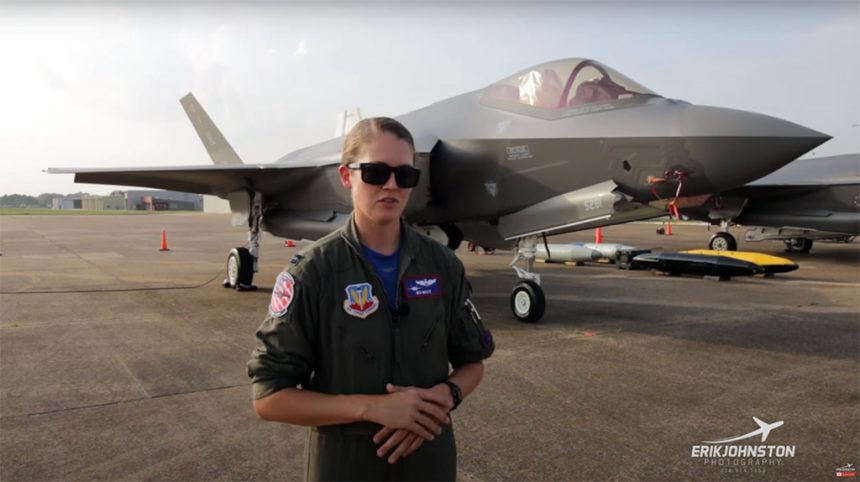F-35 Demo Pilot Capt. Kristin “Beo” Wolfe introduces you to the Lightning II stealth aircraft.
U.S. Air Force Captain Kristin “Beo” Wolfe, the F-35A Demo Team Pilot for the 2020 and 2021 air demonstration season, does not need any introduction: she is the first female F-35A Demo pilot and only the second USAF F-35A Demo Team Pilot in history. As such, she was aboard the F-35 that, on May 29, 2020, at Hill Air Force Base, Utah, flew the first-ever Lightning II demonstration that was broadcast live around the world on social media.
As you may understand, she’s one of the most qualified F-35 pilot around to guide you through a walkaround tour of the U.S. Air Force 5th generation stealth jet.
Here are some details worth a comment that I’ve noticed in the footage, filmed once again by our friend Erik Johnston.
The walkaround starts with “Beo” talking about the EOTS (Electro-Optical Targeting System) with its T-FLIR (Targeting Forward Looking Infra-Red), that provides, through the IR, a black and white display in the cockpit that shows hot things really dark, so that the pilot can see hot moving vehicles, buildings, people, etc. There’s also a laser incorporated in the system, that allows to use LGBs (Laser Guided Bombs) like GBU-12s and GBU-49s on moving targets. At 03:45 we get some details about the endurance of the aircraft that can fly 1.5 – 2 hour missions without Air-to-Air Refueling. Next is a look at the engine, capable of 40,000 lbs of thrust: “for the demo I typically take off at a reduced fuel load, so about 40,000 gross weight or less, so we are quickly to the 1:1 thrust to weight ratio that people talk about”.
At 06:00 we learn another interesting detail: F-16 travel pods are used by the F-35 demo team to carry all the things they need (from luggage, to backpacks to swag to be sold at airshows) and these travel pods fit, one in each weapons bay, inside the Lightning II, where the GBU-31, 2,000-lb bombs are attached.
At around 06:50 we are reminded about the internal gun and its 181 rounds (25 mm, bigger than many jets, not as big as the 30 mm ones of the A-10), that can be fired in a 3-sec strafe.
At 08:00 we hear something interesting about the DAS, the Distributed Aperture System, a network of six cameras around the aircraft that provide 360 degree field of view to the pilot, giving him also the ability to see through the aircraft structure (and own body), thanks to the imagery projected onto the helmet’s visor. We have heard a lot about it, but I find it interesting to learn that it is “not used a ton tactically, although it’s a cool feature”.
We don’t get a chance to have a look into the cockpit, but we know it’s a glass cockpit that only has about 20 switches. Dealing with the helmet, features images, generated by two projectors and then displayed on the inner visor, that can include DAS imagery, flight critical info (like speed, direction and altitude), tactical info (like targets, friendly aircrafts, navigation waypoints) and night vision. Another value add of the helmet is the integrated NVGs (Night Vision Googles). Until today, during night operations US pilots had to choose between NVGs and JHMCS (Joint Helmet Mounted Cueing System) because NVGs need to be mounted a few centimetres in front of the eye and would interfere with the visor, leaving no space to project the symbology.
At 11:40 mark we learn that the F-35 usually rotates between 140 and 160 knots (depending on several factors, including air density, pressure altitude, weight etc), gear must be up by 300 knots. Pattern is flown between 300 and 350 knots, landing, with AOA at 13 and airspeed again between 140 and 160 KIAS.
For additional details about the helmet and sensors of the F-35, take a look at this article we posted last year about the 360-degree video with walkaround comment by Tony “Brick” Wilson, released by Lockheed Martin.








